The first Bluetooth was developed in the
year 1994 by Sven Mattison and Jaap Haartsen. They were working in a
mobile phone company named Ericsson which is in Sweden. Then five
companies came forward and joined to form the Bluetooth special interest
group. Then they developed the Bluetooth protocol specification version
1.0 in the year 1999. It allowed to develop applications and
interactive services over the interoperable radio modules and data communication protocols.
It was meant to provide the information on the specifications,
capabilities and their architectures. More number of usage modules were
identified by the Bluetooth SIG.
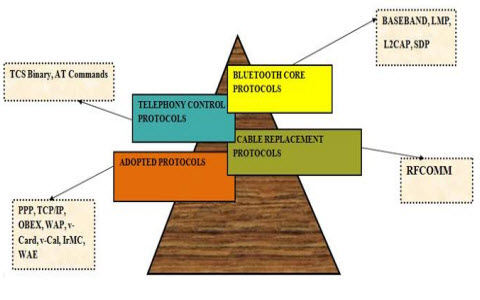
Categories of Bluetooth Protocol
What is a Bluetooth?
Bluetooth is a short range communication
technology. The Bluetooth name taken from the 10th century Danish king
Herald Blatand. Who combined Denmark and Norway.
The Bluetooth Technologies
Bluetooth technology
is a wireless system that uses radio waves for communication purpose.
It has the capability to communicate with many different devices at once
without interface. It is an open standard for short range transmission
of digital voice and the data support from the point to point and
multiplier to point applications. It has a short-range radio link and
the price is also low. When two Bluetooth devices are in 50 meters
range, then they have the connection probability. When the Bluetooth is
cut, the cord is used in digital devices. It operates with the seed of
2.45 GHz, which is available in all cases and it has some variations in
location and bandwidth. For mobile phones and business users the range
is set at 10 to 100 meters. It is possible to increase the range.
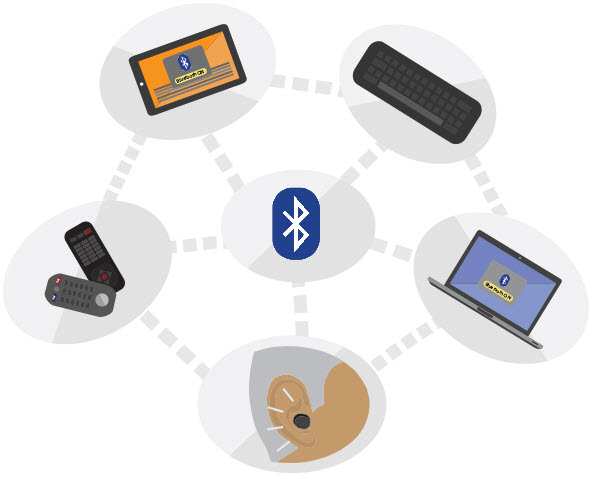
Bluetooth Technology
The speed of the gross data rate is
1bit/s, and the speed of the second generation is increased up to
2bit/s. One-to-one Bluetooth connections are allowed for a maximum speed
of data transfer, which is 723 kbits/s. The standby mode is only 0.3 ma
and it has low power consumption.
Bluetooth supports wireless point-to-point and point-to-multiple devices in Pico net.
Point-to-point link has a master and
slave relation and Bluetooth function is also same like a master and
slave; the figure below shows the master and slave relation.
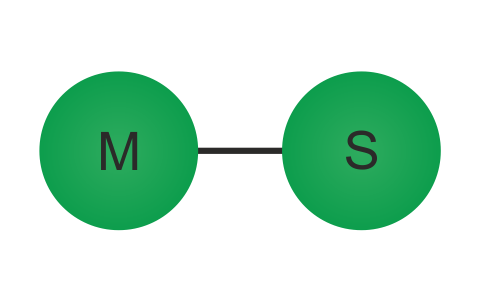
Point to Point Link
Point-to-multiple links is a network
function; it functions like a master-to-one or more slaves, but the
maximum number of slaves should be 7; the below diagram shows a clear
picture of point to multiple link.
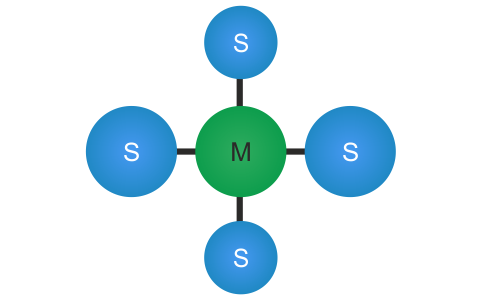
Point to Multiple Links
There are different versions of Bluetooth as given below:
| Bluetooth versions | specification |
| Bluetooth v1.0 to v1.08 | Mandatory Bluetooth hardware device and address |
| Bluetooth v1.1 | IEEE standard 802.15.1-2002 |
| Bluetooth v1.2 | Faster connection |
| Bluetooth v2.0+EDR | Enhanced data rate |
| Bluetooth v2.1 | Secure simple pairing |
| Bluetooth v3.0 | High speed data transfer |
| Bluetooth v4.0 | Low energy consumption; recently in use in apple i- phone 4s |
Bluetooth Protocol Types
The main function of the Bluetooth is a
Bluetooth protocol stack. It defines and provides different types of
layers and functionalities. Bluetooth can run different application over
different protocol stacks, but, each one of these protocol stacks uses
the same Bluetooth link and physical layers. The below diagram shows a
complete Bluetooth protocol stack. It shows the relationship between the
protocols that use the services of other protocols when there is a
payload to be transferred in the air. Anyhow, the protocols have many
other relationship between the other protocols – for example, some
protocols (L2CAP, TCS Binary) use the LMP to control the link manager.
The complete protocol stack is made up
of both Bluetooth specific protocols like object exchange protocols
(OBEX) and user datagram protocol (UDP). The main principle is to
minimize the reuse of current protocols for different purposes at higher
layers as if re-inventing circle once again. The protocol re-use is
helpful for the legacy applications to work with the Bluetooth
technology to measure the smooth operations and interoperability of
applications. Hence, many applications are being developed to take
immediate advantage of the software and hardware.
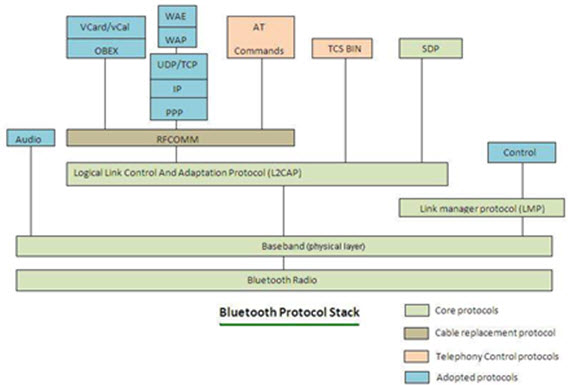
Bluetooth Protocol Stack
The Bluetooth protocols are divided into
four layers according to their purpose and aspects of Bluetooth. The
layers are given below:
| Protocol layers | Protocol in the stacks |
| Bluetooth Core Protocol | Baseband, LMP, L2CAP, SDP |
| Cable Replacement Protocol | RFCOMM |
| Telephony Control Protocol | TCS Binary, AT- commands |
| Adopted Protocols | PPP, OBEX, UDP/TCP/IP, WAP, Vcard, Vcall, IrMC, WAE |
Advantages of Bluetooth Protocols
The advantages of Bluetooth protocol are given below:
- Bluetooth offers economic wireless solution (both data & voice) for short distances.
- It is used in the mobile and stationary environment.
- There is no setup file to install the Bluetooth; it is an inbuilt device.
- Global technology specifications are used.
Characteristics of Bluetooth Protocols
Some of the characteristics of Bluetooth protocols are given below:
- Up to eight devices can be networked in the Pico net by using Bluetooth.
- Devices need not to be pointed at each other, as signals are Omni- directional.
- Governments regulated worldwide because it is possible to utilize the same standard.
- Signals can be transmitted even through walls and briefcases.
Applications of Bluetooth Protocols
The applications of Bluetooth protocols are mentioned below:
- Wireless communication with PC’s input and output devices; the most common devices include mouse, keyboard, and printer.
- Transfer of files, contact details, calendar appointment, and remainders between devices with obex.
- It is possible to send a small advertisement from a Bluetooth enabled advertising notice to other discoverable, Bluetooth device.
- In cars introduced in 2004, like the Toyota Prius and Lexus, have 430 band free call systems.
This article gives the information about
Bluetooth protocols, types of Bluetooth protocols, Bluetooth’s
advantages, applications and characteristics of the Bluetooth protocol.
We hope that the information given in this article is helpful in
providing some good insights and understanding of the project.
Furthermore, if you have any queries regarding this article or any other
electrical and electronic projects, you can comment in the below section. Here is a question for you – why Bluetooth is called as a cable replacement technology?







No comments:
Post a Comment